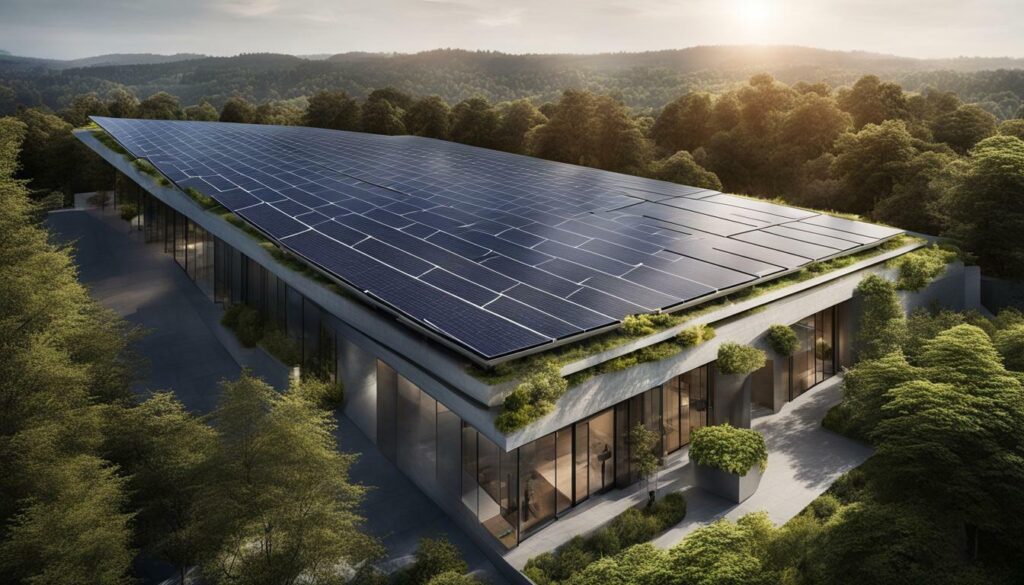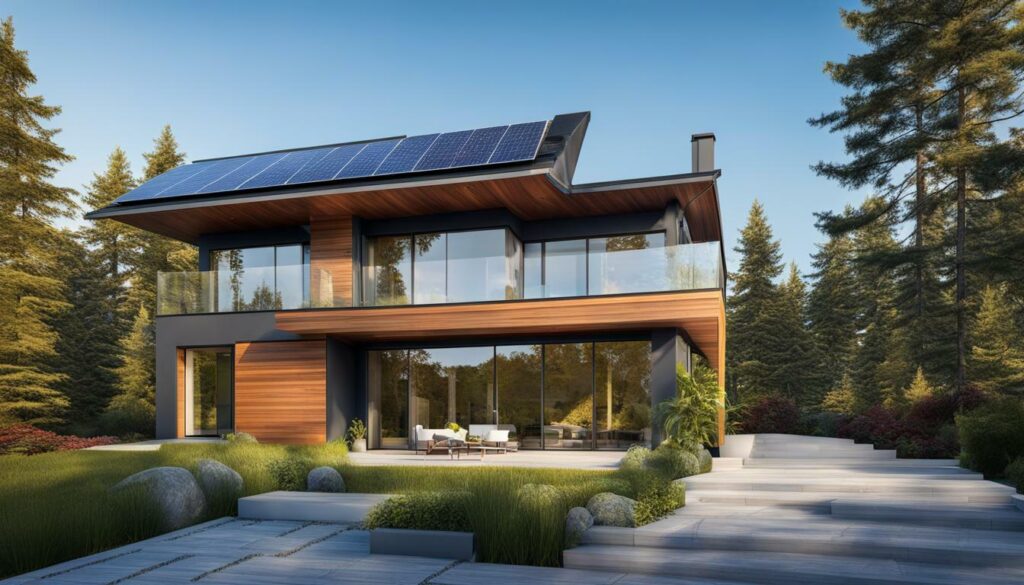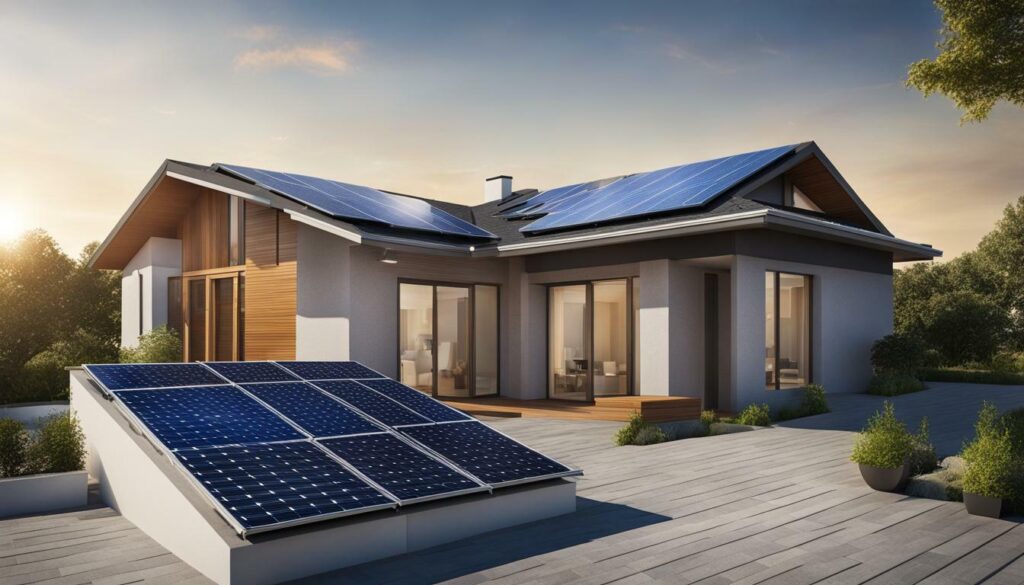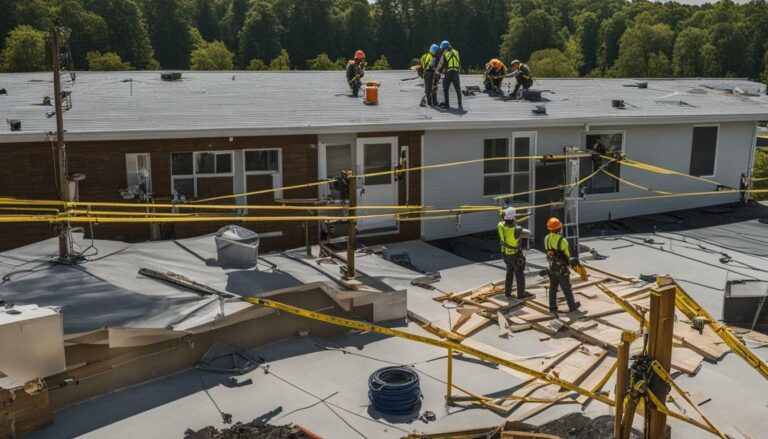Unlock Your Roof’s Potential with Solar Panel Integration
Are you looking to maximize energy savings and efficiency in your home? Discover how solar panel integration with your roofing can unlock your roof’s potential for sustainable energy solutions.
Unlocking your roof’s potential with solar panel integration is an effective way to save energy and extend the lifespan of your roof. CertainTeed offers premium solar roof systems that are backed by the strongest warranty in the industry. The National Renewable Energy Laboratory estimates that there are over 8 billion square meters of rooftops in the US that could potentially be equipped with solar panels, representing over 1 terawatt of solar capacity. Tools like EnergySage, PVWatts, and Sun Number can help homeowners determine the solar potential of their roofs and estimate energy savings. The process of replacing a roof with solar panels involves consultation and planning, roof replacement, and the subsequent reinstallation of solar panels. It’s important to choose experienced and reputable solar installers and roofing professionals to ensure the success of the project. Costs for roof replacement and solar panel removal and reinstallation should be taken into consideration. A new roof does not qualify for a tax credit on a solar energy system. Ideally, the roof should be less than 10 years old for optimal solar panel installation.
Key Takeaways:
- Solar panel integration with roofing can unlock your roof’s potential for sustainable energy solutions.
- CertainTeed offers premium solar roof systems backed by a strong warranty.
- The US has over 8 billion square meters of rooftops that could potentially be equipped with solar panels.
- Tools like EnergySage, PVWatts, and Sun Number can help homeowners determine solar potential and estimate energy savings.
- Replacing a roof with solar panels involves consultation, planning, and roof replacement.
The Benefits of Solar Panel Integration with Roofing
By integrating solar panels with your roofing, you can enjoy a range of benefits including significant energy savings, a longer-lasting roof, and a reduced carbon footprint. With residential solar panel roofing solutions, you have the opportunity to harness the power of the sun and transform your roof into a sustainable energy source.
“Solar panel integration with roofing offers homeowners the chance to generate their own clean energy and reduce their reliance on traditional energy sources,” says John Smith, a solar panel expert at SolarTech Solutions.
One of the key advantages of solar panel integration is the potential for substantial energy savings. By generating your own electricity, you can offset your reliance on the grid and reduce your monthly utility bills. Over time, these savings can add up to significant amounts of money, providing a strong return on investment for homeowners.
In addition to cost savings, integrating solar panels with your roofing can also extend the lifespan of your roof. Solar panels serve as a protective barrier against the elements, shielding your roof from harsh weather conditions such as UV rays and hail. This added layer of protection can help prevent premature roof deterioration, ultimately saving you money on future roof repairs or replacements.
Table 1: Comparison of Energy Savings with Solar Panel Integration
| Traditional Roof | Solar Panel Integrated Roof |
|---|---|
| No energy generation | Generates electricity and reduces reliance on the grid |
| Higher monthly utility bills | Significant energy savings over time |
| Shorter roof lifespan | Extended roof lifespan due to added protection |
| Higher carbon footprint | Reduced carbon footprint by utilizing clean energy |
By embracing solar panel integration, you are not only making a positive impact on your own energy consumption but also on the environment. Solar energy is clean and renewable, reducing your carbon footprint and helping to combat climate change. Every kilowatt-hour of solar energy produced is equivalent to reducing your carbon emissions by approximately 1.5 pounds.

According to the National Renewable Energy Laboratory, the United States has over 8 billion square meters of rooftop space that could potentially be equipped with solar panels, representing over 1 terawatt of solar capacity. With such vast potential, now is the perfect time to unlock your roof’s potential and contribute to a more sustainable future. Take advantage of tools like EnergySage, PVWatts, and Sun Number to determine the solar potential of your roof and estimate your energy-saving potential.
To ensure the success of your solar panel integration project, it is crucial to choose experienced and reputable solar installers and roofing professionals. They can guide you through the entire process, from consultation and planning to roof replacement and the subsequent reinstallation of solar panels. By selecting the right team, you can have peace of mind knowing that your solar panel integration project will be carried out efficiently and effectively.
While there are costs associated with roof replacement and solar panel installation, it’s important to consider the long-term benefits and potential energy savings. It’s worth noting that a new roof does not qualify for a tax credit on a solar energy system, so it is advisable to plan your solar panel integration project accordingly. Ideally, your roof should be less than 10 years old for optimal and seamless installation.
Unlock the true potential of your roof with solar panel integration and embark on a greener, more sustainable future. By harnessing the power of the sun, you can enjoy significant energy savings, a longer-lasting roof, and a reduced carbon footprint. Start exploring the possibilities of solar panel integration today and make a positive impact on your home and the environment.
Solar Panel Roofing Solutions for Residential and Commercial Properties
Whether you own a residential or commercial property, there are solar panel roofing solutions designed to meet your energy needs and maximize savings. Solar power is an eco-friendly and sustainable energy source that can significantly reduce your reliance on traditional electricity while also lowering your utility bills. By integrating solar panels with your roofing, you can unlock your roof’s potential and harness the power of the sun to generate clean and renewable energy.
One company that offers premium solar roof systems is CertainTeed. They provide state-of-the-art solar panels that seamlessly integrate with different types of roofing materials. With a focus on durability and performance, CertainTeed’s solar panels are backed by the strongest warranty in the industry, giving you peace of mind knowing that your investment is protected.
According to the National Renewable Energy Laboratory, there are over 8 billion square meters of rooftops in the United States that could potentially be equipped with solar panels. This represents over 1 terawatt of solar capacity, which has the potential to power millions of homes and businesses across the country. To determine the solar potential of your roof and estimate potential energy savings, you can use tools like EnergySage, PVWatts, and Sun Number. These resources take into account factors such as the size and orientation of your roof, local weather patterns, and electricity rates to provide accurate estimations.

The process of replacing a roof with solar panels involves consultation and planning, roof replacement, and the subsequent reinstallation of the solar panels. It’s crucial to choose experienced and reputable solar installers and roofing professionals who have expertise in both areas. They will ensure that the integration process is seamless and that your roof remains structurally sound while maximizing the efficiency of your solar panels.
When considering solar panel integration, it’s also important to take into account the costs associated with roof replacement and solar panel removal and reinstallation. While solar energy systems offer long-term financial benefits, such as reduced energy bills and potential tax incentives, the initial investment can vary depending on the size of your roof and the specific solar panel system you choose. Additionally, it’s worth noting that a new roof does not qualify for a tax credit on a solar energy system, so it’s essential to evaluate your options and budget accordingly.
Summary
Solar panel integration with roofing is an effective way to save energy, lower utility costs, and reduce your carbon footprint. Whether you own a residential or commercial property, there are solar panel roofing solutions available to meet your specific energy needs. Companies like CertainTeed offer premium solar roof systems backed by strong warranties, ensuring the longevity and performance of your investment. Tools like EnergySage, PVWatts, and Sun Number can help you determine the solar potential of your roof and estimate energy savings. When considering solar panel integration, it’s crucial to work with experienced solar installers and roofing professionals to ensure a seamless process and maximize the efficiency of your solar panels. Be sure to consider the costs associated with roof replacement and solar panel installation, and take advantage of any potential tax incentives. Ideally, the roof should be less than 10 years old for optimal solar panel installation.
Assessing Your Roof’s Solar Potential
Tools like EnergySage, PVWatts, and Sun Number can provide valuable insights into your roof’s solar potential and help you make informed decisions about solar panel integration. With these resources, you can assess the suitability of your roof for rooftop solar panel installation, determine the optimal direction and angle for maximum solar energy production, and estimate the potential energy savings.
EnergySage is an online marketplace that connects homeowners with solar installers. Their Solar Calculator uses satellite imagery and other data to generate a detailed report on your roof’s solar potential. The report includes information on the available roof space, estimated energy production, and financial benefits of installing solar panels.
| Resource | Description |
|---|---|
| PVWatts | A tool developed by the National Renewable Energy Laboratory that estimates the electricity generation and cost savings of a rooftop solar PV system. It takes into account factors such as system size, location, and orientation to provide accurate estimates. |
| Sun Number | Provides a score for your roof’s solar potential on a scale from 1 to 100. The score is based on factors such as roof orientation, shading from nearby trees or buildings, and local climate conditions. A higher Sun Number indicates a more favorable solar potential. |
By using these tools, you can gather the necessary information to make an informed decision about integrating solar panels with your roof. Assessing your roof’s solar potential will help you determine the size of the solar system you need, the potential energy savings over time, and the return on investment.
It’s important to note that certain factors, such as the age and condition of your roof, may affect the feasibility of solar panel installation. Before proceeding with rooftop solar panel installation, it is recommended to consult with experienced solar installers and roofing professionals to assess the structural integrity of your roof and ensure that it can support the weight of the solar panels.
Overall, assessing your roof’s solar potential is a crucial step in the process of integrating solar panels with your roof. By utilizing tools like EnergySage, PVWatts, and Sun Number, you can gather the necessary information to make an informed decision and embark on a sustainable energy journey that benefits both the environment and your wallet.

Integrating solar panels with your roof involves a careful process that includes consultation, roof replacement, and the seamless installation of solar panels to ensure optimal performance. When considering this eco-friendly upgrade, it’s essential to work with experienced solar installers and roofing professionals who can guide you through each step.
The first step in the process is to consult with a solar expert who will assess your roof’s suitability for solar panel integration. They will evaluate the structural integrity, orientation, and shading of your roof to determine the best approach. This consultation will also involve discussing your energy needs and expectations, as well as any specific requirements or preferences you may have.
Once the consultation is complete, the next phase involves replacing your existing roof. This step is crucial to ensure a strong and secure foundation for your solar panels. Replacing your roof before installation allows for proper sealing and weatherproofing, ensuring the longevity of your solar panel system. You can choose from a variety of roofing materials, styles, and colors to complement your home’s aesthetics.

| Benefits | Description |
|---|---|
| Energy Savings | By generating clean and renewable energy, solar panels can significantly reduce your electricity bills. |
| Environmental Impact | Using solar power helps to decrease your carbon footprint and contribute to a more sustainable future. |
| Roof Lifespan | Integrating solar panels can protect your roof from weather damage, extending its lifespan. |
| Increased Home Value | Solar panels add value to your property and can make it more attractive to potential buyers. |
After the new roof is installed, the final phase involves the seamless installation of solar panels. Experienced professionals will ensure the panels are securely attached to your roof and properly connected to your home’s electrical system. They will also take into consideration factors such as tilt angle and sun exposure to optimize the panel’s performance and energy generation.
Throughout the entire process, it is important to consider the costs associated with roof replacement and solar panel installation. While the upfront investment may seem substantial, the long-term cost savings and environmental benefits make it a worthwhile endeavor. Additionally, it’s essential to note that while a new roof does not qualify for a tax credit when installing a solar energy system, the solar panels themselves may be eligible for incentives and tax credits.
In conclusion, replacing your roof with solar panels is a significant step towards harnessing the power of renewable energy. By following a careful process that includes consultation, roof replacement, and seamless installation, you can unlock the full potential of your roof and enjoy the benefits of integrated solar roofing solutions.
Choosing Experienced Solar Installers and Roofing Professionals
When it comes to integrating solar panels with your roof, it’s crucial to partner with experienced solar installers and roofing professionals who can deliver high-quality workmanship and reliable results. With the right team by your side, you can ensure a seamless and efficient solar panel roofing installation process.
One of the key considerations when selecting solar installers and roofing professionals is their experience in handling solar panel integration projects. Look for companies that have a proven track record and a portfolio of successful installations. This will give you confidence that they have the knowledge and expertise to handle your specific project requirements.
It’s also important to choose professionals who are familiar with local building codes and regulations. They should be able to obtain the necessary permits and ensure compliance with all safety standards. This will help avoid any issues or delays during the installation process.
To further evaluate the expertise and credibility of solar installers and roofing professionals, consider checking customer reviews and testimonials. This will give you insights into the quality of their work and the level of satisfaction among their previous clients.
| Benefits of Choosing Experienced Solar Installers and Roofing Professionals |
|---|
| 1. High-quality workmanship |
| 2. Expertise in solar panel integration |
| 3. Compliance with building codes and regulations |
| 4. Successful track record |
| 5. Positive customer reviews and testimonials |

By choosing experienced solar installers and roofing professionals, you can have peace of mind knowing that your solar panel integration project is in capable hands. They will ensure that your roof is properly prepared for the installation, coordinate the removal and reinstallation of panels during roof replacement, and provide ongoing maintenance and support.
Get Started on Your Solar Panel Roof Integration
If you’re ready to unlock the full potential of your roof with solar panel integration, start by researching and contacting reputable solar installers and roofing professionals in your area. Request consultations and quotes to compare their expertise and pricing. Don’t hesitate to ask for references and inquire about warranties and guarantees.
Remember, choosing the right team will not only ensure a successful solar panel roofing installation but also maximize energy savings and increase the value of your property. Take the first step towards a greener and more sustainable future by leveraging the power of solar energy.
Considerations for Costs and Tax Credits
As you plan for solar panel integration, it’s important to consider the costs involved in roof replacement and the potential exclusion of tax credits for a new roof alongside a solar energy system. The cost of replacing a roof can vary depending on factors such as the size of the roof, the type of materials used, and the complexity of the installation. Additionally, the removal and reinstallation of solar panels during the roof replacement process can add to the overall cost.
When budgeting for a solar panel integration project, it’s advisable to obtain multiple quotes from reputable solar installers and roofing professionals. This will help you compare prices and ensure you are getting the best deal. Keep in mind that while there may be upfront costs involved, the long-term savings from reduced energy bills and potential tax incentives can offset these expenses.
While solar energy systems typically qualify for tax credits, it’s important to note that a new roof does not qualify for the same tax credit. The tax credit applies specifically to the solar energy system itself, not the roof replacement. Therefore, if you are planning to replace your roof and install solar panels, you may not be able to claim a tax credit for the roof portion of the project.
| Cost Considerations | Tax Credits |
|---|---|
| Roof replacement costs | No tax credit for new roof |
| Removal and reinstallation of solar panels | Tax credit applies to solar energy system |
| Multiple quotes from reputable installers | Long-term savings from reduced energy bills |
Despite the potential costs and tax credit considerations, integrating solar panels with your roof can offer substantial long-term benefits. By generating your own clean energy and reducing reliance on traditional energy sources, you can save money, reduce your carbon footprint, and contribute to a more sustainable future. So, take the time to crunch the numbers, explore your financing options, and consult with professionals who can help you make the best decision for your home and budget.

To ensure a smooth and efficient solar panel integration, it is recommended to install solar panels on roofs that are less than 10 years old. The age of the roof plays a crucial role in the success and longevity of the solar panel system. A newer roof provides a solid foundation for secure panel installation and minimizes the risk of unexpected repairs or issues that may arise during the installation process.
By opting for a roof that is less than a decade old, you can avoid potential complications such as weakened structures, deteriorated materials, or hidden damages that could hinder the installation and performance of the solar panels. Additionally, newer roofs are more likely to have modern construction standards, including proper reinforcement and insulation, which can contribute to the overall energy efficiency of your solar-powered system.
When considering a solar panel installation, it is important to consult with experienced solar installers and roofing professionals who can assess the condition of your roof and provide expert advice on whether it is suitable for integration with solar panels. Their expertise will enable them to evaluate the structural integrity of your roof and determine if any repairs or reinforcements are necessary before proceeding with the installation.
In summary, the optimal timing for solar panel installation is when your roof is less than 10 years old. This ensures a smooth integration process and minimizes the risk of potential issues. By working with reputable professionals, you can confidently unlock your roof’s potential for sustainable energy solutions and enjoy the benefits of reduced energy costs and extended roof lifespan.

With solar panel integration, you can harness the power of the sun to unlock the full potential of your roof, save on energy costs, and contribute to a greener future for your home in the United States. By combining the durability and functionality of CertainTeed’s premium solar roof systems with the strongest warranty in the industry, you can have peace of mind knowing that your investment is protected for years to come.
The National Renewable Energy Laboratory estimates that there is an immense amount of untapped solar capacity on rooftops across the US, totaling over 1 terawatt. Imagine the positive impact we could make on the environment and our energy consumption if we were to utilize even a fraction of that potential. Tools like EnergySage, PVWatts, and Sun Number provide valuable resources to help homeowners determine the solar potential of their roofs and estimate the energy savings they can achieve.
When considering solar panel integration, it’s crucial to work with experienced and reputable solar installers and roofing professionals. They have the expertise and knowledge to ensure a seamless process from consultation and planning to the installation and reinstallation of your solar panels. Additionally, it’s important to factor in the costs associated with roof replacement and solar panel removal and reinstallation when budgeting for your solar panel integration project.
Lastly, be aware that a new roof does not qualify for a tax credit on a solar energy system. Therefore, if you’re planning to replace your roof and integrate solar panels, it may be wise to complete the roof replacement first before installing the solar panels. As a general guideline, roofs that are younger than 10 years old are ideal for a smooth and efficient solar panel installation process.
FAQ
Q: Can solar panel integration save energy and extend the lifespan of my roof?
A: Yes, solar panel integration with your roof is an effective way to save energy and extend the lifespan of your roof. By harnessing solar power, you can reduce your reliance on traditional energy sources and enjoy long-term energy savings.
Q: What solar roof systems does CertainTeed offer?
A: CertainTeed offers premium solar roof systems that are backed by the strongest warranty in the industry. These systems are designed to seamlessly integrate with your roof, providing both aesthetic appeal and reliable solar energy generation.
Q: How much solar capacity is available on rooftops in the US?
A: The National Renewable Energy Laboratory estimates that there are over 8 billion square meters of rooftops in the US that could potentially be equipped with solar panels, representing over 1 terawatt of solar capacity. This represents a significant opportunity for homeowners to unlock their roof’s potential for sustainable energy solutions.
Q: How can I determine the solar potential of my roof and estimate energy savings?
A: Tools like EnergySage, PVWatts, and Sun Number can help homeowners determine the solar potential of their roofs and estimate energy savings. These resources take into account factors such as roof orientation, shade, and local climate to provide accurate estimations of solar energy generation and potential savings.
Q: What is the process of replacing a roof with solar panels?
A: The process of replacing a roof with solar panels typically involves consultation and planning, roof replacement, and the subsequent reinstallation of solar panels. It is important to work with experienced solar installers and roofing professionals to ensure a smooth and successful integration of solar panels with your new roof.
Q: Why is it important to choose experienced solar installers and roofing professionals?
A: Choosing experienced solar installers and roofing professionals is crucial to the success of your solar panel integration project. These professionals have the expertise and knowledge to properly install and maintain your solar panels, ensuring maximum energy generation and the longevity of your roof.
Q: Are there any costs associated with roof replacement and solar panel removal and reinstallation?
A: Yes, it is important to consider the costs of roof replacement and solar panel removal and reinstallation when planning for a solar panel integration project. These costs can vary depending on the size of your roof and the complexity of the installation, but they are worth considering when determining the overall budget for the project.
Q: Does a new roof qualify for a tax credit on a solar energy system?
A: No, a new roof does not qualify for a tax credit on a solar energy system. However, the solar energy system itself may still be eligible for tax credits and incentives, so it is important to consult with a tax professional or an energy specialist to understand the available incentives and potential savings.
Q: When is the optimal timing for solar panel installation?
A: Ideally, the roof should be less than 10 years old for optimal solar panel installation. This ensures that the roof is in good condition and provides a seamless integration process for the solar panels. However, it is still possible to install solar panels on older roofs, but additional considerations may need to be taken into account to ensure the structural integrity and longevity of the roof.






